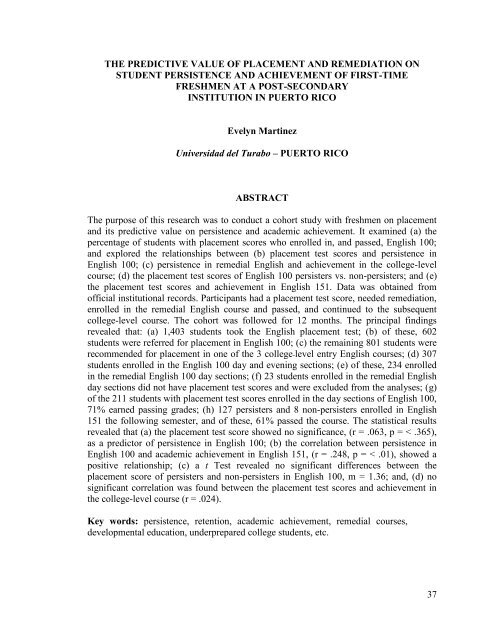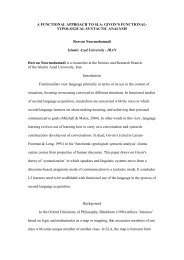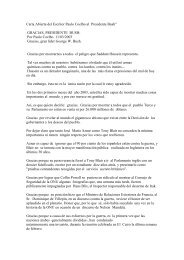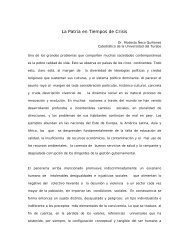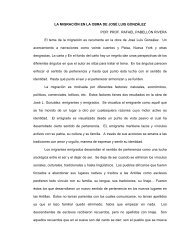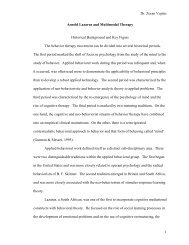UNIVERSIDAD DEL TURABO - Biblioteca virtual de la Universidad ...
UNIVERSIDAD DEL TURABO - Biblioteca virtual de la Universidad ...
UNIVERSIDAD DEL TURABO - Biblioteca virtual de la Universidad ...
Create successful ePaper yourself
Turn your PDF publications into a flip-book with our unique Google optimized e-Paper software.
THE PREDICTIVE VALUE OF PLACEMENT AND REMEDIATION ON<br />
STUDENT PERSISTENCE AND ACHIEVEMENT OF FIRST-TIME<br />
FRESHMEN AT A POST-SECONDARY<br />
INSTITUTION IN PUERTO RICO<br />
Evelyn Martinez<br />
<strong>Universidad</strong> <strong>de</strong>l Turabo – PUERTO RICO<br />
ABSTRACT<br />
The purpose of this research was to conduct a cohort study with freshmen on p<strong>la</strong>cement<br />
and its predictive value on persistence and aca<strong>de</strong>mic achievement. It examined (a) the<br />
percentage of stu<strong>de</strong>nts with p<strong>la</strong>cement scores who enrolled in, and passed, English 100;<br />
and explored the re<strong>la</strong>tionships between (b) p<strong>la</strong>cement test scores and persistence in<br />
English 100; (c) persistence in remedial English and achievement in the college-level<br />
course; (d) the p<strong>la</strong>cement test scores of English 100 persisters vs. non-persisters; and (e)<br />
the p<strong>la</strong>cement test scores and achievement in English 151. Data was obtained from<br />
official institutional records. Participants had a p<strong>la</strong>cement test score, nee<strong>de</strong>d remediation,<br />
enrolled in the remedial English course and passed, and continued to the subsequent<br />
college-level course. The cohort was followed for 12 months. The principal findings<br />
revealed that: (a) 1,403 stu<strong>de</strong>nts took the English p<strong>la</strong>cement test; (b) of these, 602<br />
stu<strong>de</strong>nts were referred for p<strong>la</strong>cement in English 100; (c) the remaining 801 stu<strong>de</strong>nts were<br />
recommen<strong>de</strong>d for p<strong>la</strong>cement in one of the 3 college-level entry English courses; (d) 307<br />
stu<strong>de</strong>nts enrolled in the English 100 day and evening sections; (e) of these, 234 enrolled<br />
in the remedial English 100 day sections; (f) 23 stu<strong>de</strong>nts enrolled in the remedial English<br />
day sections did not have p<strong>la</strong>cement test scores and were exclu<strong>de</strong>d from the analyses; (g)<br />
of the 211 stu<strong>de</strong>nts with p<strong>la</strong>cement test scores enrolled in the day sections of English 100,<br />
71% earned passing gra<strong>de</strong>s; (h) 127 persisters and 8 non-persisters enrolled in English<br />
151 the following semester, and of these, 61% passed the course. The statistical results<br />
revealed that (a) the p<strong>la</strong>cement test score showed no significance, (r = .063, p = < .365),<br />
as a predictor of persistence in English 100; (b) the corre<strong>la</strong>tion between persistence in<br />
English 100 and aca<strong>de</strong>mic achievement in English 151, (r = .248, p = < .01), showed a<br />
positive re<strong>la</strong>tionship; (c) a t Test revealed no significant differences between the<br />
p<strong>la</strong>cement score of persisters and non-persisters in English 100, m = 1.36; and, (d) no<br />
significant corre<strong>la</strong>tion was found between the p<strong>la</strong>cement test scores and achievement in<br />
the college-level course (r = .024).<br />
Key words: persistence, retention, aca<strong>de</strong>mic achievement, remedial courses,<br />
<strong>de</strong>velopmental education, un<strong>de</strong>rprepared college stu<strong>de</strong>nts, etc.<br />
37
RESUMEN ABSTRACTO<br />
El propósito <strong>de</strong> esta investigación fue llevar a cabo un estudio con pruebas <strong>de</strong> ubicación<br />
en un grupo <strong>de</strong> estudiantes <strong>de</strong> primer año para medir su valor predictivo en persistencia<br />
y logro académico. Se examinó (a) el porcentaje <strong>de</strong> estudiantes con calificaciones <strong>de</strong><br />
ubicación que se matricu<strong>la</strong>ron y aprobaron Inglés 100; y se exploró <strong>la</strong> re<strong>la</strong>ción entre (b)<br />
calificaciones en pruebas <strong>de</strong> ubicación y persistencia en Inglés 100; (c) persistencia en<br />
Inglés remedial y <strong>de</strong>sempeño en cursos a nivel colegial; (d) <strong>la</strong> calificación en exámenes<br />
<strong>de</strong> ubicación en Inglés 100 estudiantes persistentes vs. no persistentes; y (e) <strong>la</strong>s<br />
calificaciones en pruebas <strong>de</strong> ubicación y <strong>de</strong>sempeño en Inglés 151. Los datos fueron<br />
obtenidos <strong>de</strong> los archivos institucionales oficiales. Los participantes tuvieron una<br />
puntuación en exámenes <strong>de</strong> ubicación, necesitaron remediación, se matricu<strong>la</strong>ron en el<br />
curso remedial <strong>de</strong> Inglés y pasaron, y continuaron al subsiguiente curso a nivel colegial.<br />
El grupo fue seguido por 12 meses. Los datos principales reve<strong>la</strong>n que: (a) 1,403<br />
estudiantes tomaron el examen <strong>de</strong> ubicación <strong>de</strong> Inglés; (b) <strong>de</strong> éstos, 602 fueron referidos<br />
a reubicarse en Inglés 100; (c) los 801 estudiantes restantes fueron recomendados a ser<br />
ubicados en uno <strong>de</strong> los tres cursos <strong>de</strong> Inglés a nivel <strong>de</strong> colegial; (d) 307 estudiantes se<br />
matricu<strong>la</strong>ron en secciones <strong>de</strong> Inglés 100 <strong>de</strong> día y <strong>de</strong> noche; (e) <strong>de</strong> éstos 234 se<br />
matricu<strong>la</strong>ron en el curso <strong>de</strong> Inglés remedial 100, el 71% obtuvo nota <strong>de</strong> aprobación; (h)<br />
127 persistentes y 8 no persistentes se matricu<strong>la</strong>ron en Inglés 151 el siguiente semestre,<br />
<strong>de</strong> éstos el 61% pasó el curso. Los resultados estadísticos reve<strong>la</strong>n que (a) <strong>la</strong> prueba <strong>de</strong><br />
ubicación no es significativa, (r =.063, p =
Introduction<br />
Stu<strong>de</strong>nt persistence and stu<strong>de</strong>nt retention are terms utilized by researchers to<br />
i<strong>de</strong>ntify a stu<strong>de</strong>nt‟s continued enrollment at an institution from one semester to another.<br />
Stu<strong>de</strong>nt attrition and stu<strong>de</strong>nt dropout refer to a stu<strong>de</strong>nt‟s failure to re-enroll. <strong>Universidad</strong><br />
<strong>de</strong>l Turabo, i.e., the University of Turabo (UT) is concerned about the problem of stu<strong>de</strong>nt<br />
attrition and accountability in the use of its resources. Stu<strong>de</strong>nt retention is a challenge and<br />
a major concern for the university‟s fiscal survival. Annually, the institution applies early<br />
intervention strategies through mandatory p<strong>la</strong>cement testing that contribute to the<br />
reduction of stu<strong>de</strong>nt attrition by i<strong>de</strong>ntifying stu<strong>de</strong>nts who are un<strong>de</strong>rprepared or who might<br />
be at-risk and likely to drop out. Un<strong>de</strong>rprepared and at-risk stu<strong>de</strong>nts are tested into the<br />
remedial English course. However, there is no data that measures the effect that the<br />
remedial English course has on the aca<strong>de</strong>mic performance and retention of stu<strong>de</strong>nts.<br />
Boy<strong>la</strong>n, Bonham, and Tafari (2005) proffer that colleges that regu<strong>la</strong>rly evaluate their<br />
remedial course outcomes often have higher rates of retention for stu<strong>de</strong>nts in remedial<br />
courses.<br />
In the light of this, the current study documented (a) the percentage of stu<strong>de</strong>nts<br />
with p<strong>la</strong>cement scores at UT who enrolled and persisted in English 100; and explored the<br />
re<strong>la</strong>tionships between (b) stu<strong>de</strong>nts‟ English p<strong>la</strong>cement test scores and persistence in<br />
English 100; (c) stu<strong>de</strong>nt persistence in the remedial English 100 course and achievement<br />
in the college-level English 151 course; (d) English 100 persisters vs. non-persisters and<br />
the English p<strong>la</strong>cement test scores; and (e) stu<strong>de</strong>nts‟ English p<strong>la</strong>cement test scores and<br />
achievement in English 151. This research is important and groundbreaking because it<br />
39
provi<strong>de</strong>s insight into the impact of p<strong>la</strong>cement testing on new enrollees and current tertiary<br />
educational practices and policies.<br />
Background<br />
Remedial education provi<strong>de</strong>s opportunities for entering freshmen stu<strong>de</strong>nts who<br />
<strong>la</strong>ck the aca<strong>de</strong>mic skills to succeed in postsecondary education. Public and private<br />
institutions of higher education in the United States mandate remedial courses in reading,<br />
writing and mathematics for college work at the level required by the institution. The<br />
results of low achievement scores on state or territorial exams have led universities and<br />
colleges to require p<strong>la</strong>cement exams for un<strong>de</strong>rprepared first-time entering stu<strong>de</strong>nts prior<br />
to registration. Data provi<strong>de</strong>d by the National Center for Educational Statistics (NCES),<br />
2003 showed that in fall 2000, the most common approach to select stu<strong>de</strong>nts for remedial<br />
coursework was to give p<strong>la</strong>cement tests to all entering stu<strong>de</strong>nts. Survey results confirmed<br />
“57 to 61% of institutions used this approach for remedial reading, writing, and<br />
mathematics courses” (p. 2). Another national report released by the NCES on<br />
postsecondary institution enrollment showed that from 1970 to 2005, enrollment in all<br />
<strong>de</strong>gree-granting institutions “rose from 8.5 million to about 17.1 million stu<strong>de</strong>nts”<br />
(Syn<strong>de</strong>r, Dillow, & Hoffman, 2007, p. 261). At the same time that enrollment increased<br />
in colleges and universities, there was a significant increase in remedial / <strong>de</strong>velopmental<br />
skills programs in response to the <strong>la</strong>rge number of entering un<strong>de</strong>rprepared first-time<br />
college stu<strong>de</strong>nts.<br />
Poor aca<strong>de</strong>mic preparation for college work has prevailed as a feature of<br />
American education during the past three hundred years. In the 17 th century, Latin and<br />
40
Greek were the <strong>la</strong>nguages of postsecondary education and unprepared entering stu<strong>de</strong>nts<br />
who could not read the <strong>la</strong>nguages of the scho<strong>la</strong>rly works were provi<strong>de</strong>d tutoring c<strong>la</strong>sses<br />
(Boy<strong>la</strong>n, 1988). In the early 19 th century, un<strong>de</strong>rprepared stu<strong>de</strong>nts atten<strong>de</strong>d college<br />
without prior aca<strong>de</strong>mic preparation and it was necessary to provi<strong>de</strong> individual tutoring<br />
(Boy<strong>la</strong>n & White, 1988). As college enrollments increased, the University of Wisconsin<br />
established, in 1849, the first college preparatory <strong>de</strong>partment to attend the needs of<br />
un<strong>de</strong>rprepared stu<strong>de</strong>nts to do college-level work. It provi<strong>de</strong>d remedial coursework in<br />
reading, writing, and mathematics to improve the basic skills of first-time freshmen to do<br />
college-level work (Phipps, 1998). In 1869, Charles W. Eliot‟s inaugural address as<br />
presi<strong>de</strong>nt of Harvard University sustained the importance of supplementing the aca<strong>de</strong>mic<br />
<strong>de</strong>ficiencies that stu<strong>de</strong>nts brought from the American school. He believed that “whatever<br />
elementary instruction the schools fail to give, the college must supply” (Spann, 2000, p.<br />
2).<br />
In 1907, over 50% of stu<strong>de</strong>nts admitted to Ivy League institutions such as<br />
Harvard, Yale, Columbia, and Princeton did not have the minimum admissions<br />
requirements to do successful college work and were offered remedial courses in reading<br />
and study skills (Barnett, 2003; Wyatt, 1992). Soon after, 80% of universities and other<br />
colleges in the U.S. offered remedial education (Boy<strong>la</strong>n & White, 1988; Breneman &<br />
Haarlow, 1998; Ignash, 1997; Payne & Lyman, 1996; Pintozzi, 1987).<br />
During the mid 20 th century, remedial education became part of the purpose and<br />
meaning of junior colleges. Currently, most community colleges, 4-year colleges and<br />
universities offer remedial courses to new enrollees, but the greatest numbers of<br />
41
un<strong>de</strong>rprepared stu<strong>de</strong>nts in remedial courses are enrolled in community colleges (NCES,<br />
2003).<br />
Remedial education has become a major concern of higher education since the<br />
1970s. National estimates on the prevalence of remedial courses in <strong>de</strong>gree-granting 2-<br />
year and 4-year postsecondary institutions show that, in 2000, “75 to 82 percent of the<br />
institutions required stu<strong>de</strong>nts who were <strong>de</strong>termined to need remediation” (Parsad &<br />
Lewis, 2003, p. v) to enroll in the required remedial course.<br />
Remedial course work is established by state or institutional mandatory p<strong>la</strong>cement<br />
testing. Mandatory p<strong>la</strong>cement tests and mandatory cut-off scores help postsecondary<br />
institutions p<strong>la</strong>ce less aca<strong>de</strong>mically prepared stu<strong>de</strong>nts in c<strong>la</strong>sses at levels appropriate to<br />
their skills; c<strong>la</strong>sses that have been <strong>de</strong>veloped to provi<strong>de</strong> the required skills to help<br />
stu<strong>de</strong>nts succeed in college-level courses (Prince, 2005).<br />
Mandatory p<strong>la</strong>cement obligates first-time entering stu<strong>de</strong>nts to comply with this<br />
admissions criterion prior to enrollment. Some institutions will <strong>de</strong>tain enrollment if the<br />
p<strong>la</strong>cement test is not taken. (California State University, 2008; John Jay College of<br />
Criminal Justice-City University of New York, 2008; Long Is<strong>la</strong>nd University, 2008;<br />
Rutgers University, 2008).<br />
The literature shows that p<strong>la</strong>cement and achievement have been major concerns<br />
affecting aca<strong>de</strong>mic outcomes at community colleges (Boy<strong>la</strong>n & Saxon, 1998; Campbell<br />
& B<strong>la</strong>key, 1996; Kreysa, 2006; Long & Amey, 1993; Parsad & Lewis, 2003; Zhao,<br />
1999). In the early nineties, Long and Amey (1993) found that little research had been<br />
conducted re<strong>la</strong>ted to the successful outcomes of un<strong>de</strong>rprepared stu<strong>de</strong>nts. To assess<br />
institutional effectiveness on community college un<strong>de</strong>rprepared stu<strong>de</strong>nts, they measured<br />
42
the assessment and p<strong>la</strong>cement of 313 un<strong>de</strong>rprepared stu<strong>de</strong>nts in a <strong>de</strong>velopmental reading<br />
or English course. The study i<strong>de</strong>ntified successful and unsuccessful groups of<br />
un<strong>de</strong>rprepared stu<strong>de</strong>nts. Findings showed that stu<strong>de</strong>nts who completed the <strong>de</strong>velopmental<br />
reading or English course increased their chances for success and completed other<br />
college-level courses. The study affirmed that more institutional policies were nee<strong>de</strong>d to<br />
enforce p<strong>la</strong>cement during the first semester of enrollment. It also stressed the importance<br />
of testing, and affirmed that “mandatory p<strong>la</strong>cement in <strong>de</strong>velopmental courses… seems<br />
vital as a key to helping un<strong>de</strong>rprepared stu<strong>de</strong>nts succeed in meeting their educational<br />
goals” (p. 14).<br />
Mandatory testing for p<strong>la</strong>cement in appropriate remedial or college-level courses<br />
is a significant concern for postsecondary institutions serving un<strong>de</strong>rprepared stu<strong>de</strong>nts.<br />
With <strong>la</strong>rge numbers of these stu<strong>de</strong>nts seeking admission to postsecondary institutions,<br />
Campbell and B<strong>la</strong>key (1996) researched the impact of early remediation on the<br />
persistence and / or performance of un<strong>de</strong>rprepared stu<strong>de</strong>nts at a community college. The<br />
results confirmed the success of first year remedial course-taking and its significant<br />
impact on stu<strong>de</strong>nt persistence. Zhao (1999) investigated the impact of remediation on the<br />
achievement of <strong>de</strong>gree-seeking stu<strong>de</strong>nts. Through this study, Factors Affecting Aca<strong>de</strong>mic<br />
Outcomes of Un<strong>de</strong>rprepared Community College Stu<strong>de</strong>nts, issues that affected the<br />
aca<strong>de</strong>mic performance and outcomes of 1,249 un<strong>de</strong>rprepared stu<strong>de</strong>nts at Prince George‟s<br />
Community College in Mary<strong>la</strong>nd were investigated to <strong>de</strong>termine if remediation<br />
completion and <strong>de</strong>velopmental course-taking were significant predictors of aca<strong>de</strong>mic<br />
achievement. Results showed that completion of remedial courses was one of the<br />
predictors of achievement. The study also posited that the new millennium would bring<br />
43
an increase in enrollment, more open-admission policies at community colleges and an<br />
increase among the un<strong>de</strong>rprepared stu<strong>de</strong>nt popu<strong>la</strong>tion. The trend would encourage<br />
institutional researchers to take new initiatives to improve the aca<strong>de</strong>mic progress rates of<br />
un<strong>de</strong>rprepared stu<strong>de</strong>nts and to evaluate <strong>de</strong>velopmental education programs in response to<br />
accountability <strong>de</strong>mands.<br />
According to Boy<strong>la</strong>n and Saxon (1998), the purpose of remedial courses is to<br />
teach stu<strong>de</strong>nts the basic skills that are required by the institution to pass college-level<br />
courses. They posit that if remedial courses are successful, “some increased retention<br />
might, in<strong>de</strong>ed, be an expected result” (p. 16). To <strong>de</strong>monstrate the causal re<strong>la</strong>tionship<br />
between remediation and retention, Boy<strong>la</strong>n and Saxon (1998) reported survey results<br />
from the NCES, which “indicated that stu<strong>de</strong>nts who participate in remediation are likely<br />
to be retained at rates at least as high as and frequently higher than those who do not: a<br />
finding that has been fairly consistent in all studies conducted since 1983” (p. 20).<br />
The new millennium has seen an increase in remediation programs among<br />
community colleges, colleges, and universities. Kreysa (2006) posits in The Impact of<br />
Remediation on Persistence of Un<strong>de</strong>rgraduate College Stu<strong>de</strong>nts that many institutions<br />
advise stu<strong>de</strong>nts to enroll in remedial courses that provi<strong>de</strong> un<strong>de</strong>rprepared stu<strong>de</strong>nts the<br />
aca<strong>de</strong>mic preparation for college-level courses. He states that the “purpose of these<br />
programs is to help stu<strong>de</strong>nts from <strong>de</strong>prived - often economically or socially<br />
disadvantaged - backgrounds to catch up aca<strong>de</strong>mically with their peers”<br />
(p. 252), compete effectively, and complete their entire course of study.<br />
National reports on the number of institutions of higher education offering<br />
remedial courses support the dire need to help un<strong>de</strong>rprepared stu<strong>de</strong>nts <strong>de</strong>velop the<br />
44
a<strong>de</strong>quate skills to do college entry work. A study released by the NCES‟ Postsecondary<br />
Education Quick Information System (PEQIS) provi<strong>de</strong>d national estimates on the<br />
prevalence and characteristics of remedial courses and enrollment in two-year and four-<br />
year postsecondary institutions in the fall of 2000. The study revealed that “<strong>virtual</strong>ly, 98<br />
percent of public two-year colleges and 80 percent of public four-year institutions offered<br />
at least one remedial reading, writing or mathematics course in fall 2000” (Thomas, 2003,<br />
p. 1). Concerned with the rising numbers of stu<strong>de</strong>nts requiring remedial coursework, U.S.<br />
Education Secretary, Rod Paige, stated, “in today‟s world remediation is necessary”<br />
(Thomas, 2003, p. 1). Paige expressed hope that through „No Child Left Behind‟, primary<br />
and secondary education can be strengthened “so that all stu<strong>de</strong>nts enter the postsecondary<br />
world as prepared as possible” (as cited in Thomas, 2003, p. 1).<br />
Remediation is not circumscribed to universities and colleges in the U.S. Many<br />
universities throughout the world provi<strong>de</strong> remedial education “to bring new stu<strong>de</strong>nts to a<br />
level in basic subjects that will serve as a proper foundation” (Urashima & Ito, 2005, p.<br />
83). Scot<strong>la</strong>nd offers remedial courses in Basic English and grammar. Nearly half of<br />
Scot<strong>la</strong>nd‟s universities have been forced to provi<strong>de</strong> remedial fast-track c<strong>la</strong>sses because of<br />
plunging literacy levels in schools. Scottish un<strong>de</strong>rgraduates are not ready for the<br />
linguistic and literary <strong>de</strong>mands of <strong>de</strong>grees after leaving school. “Some stu<strong>de</strong>nts could not<br />
write, spell, or punctuate simple sentences” (BBC News, 2004, p. 1). Simi<strong>la</strong>rly, Japan<br />
offers remedial courses in math (Urashima & Ito, 2005), Canada provi<strong>de</strong>s remedial<br />
courses in English (University of Victoria, 2008), and India offers remedial courses to<br />
aca<strong>de</strong>mically weak stu<strong>de</strong>nts in colleges affiliated to Panjab University (Bariana, 2001).<br />
The United Nations Educational, Scientific, and Cultural Organization (UNESCO)<br />
45
inclu<strong>de</strong>d in its 1998 Framework for Priority Action for Change and Development in<br />
Higher Education at National Level that institutions of higher education “provi<strong>de</strong>, where<br />
appropriate, guidance and counseling, remedial courses, training in how to study and<br />
other forms of stu<strong>de</strong>nt support, including measures to improve stu<strong>de</strong>nt living conditions”<br />
(UNESCO, 1998, p. 6).<br />
Remedial education has been an issue of <strong>de</strong>bate among university presi<strong>de</strong>nts and<br />
public policy makers. While some promote the need to educate the un<strong>de</strong>rrepresented,<br />
others criticize remediation for its cost and the failure of the public schools to prepare<br />
stu<strong>de</strong>nts for college work. Opponents and proponents still continue, as they did in the<br />
past, to b<strong>la</strong>me the public school system for the <strong>de</strong>ficiencies of its high school graduates<br />
and their unpreparedness for college work. It seems that the historical <strong>de</strong>bate over the<br />
role of higher education in the 19 th century continues to be a major concern among<br />
universities and colleges in the 21 st century. As long as the K-12 system fails to<br />
aca<strong>de</strong>mically prepare stu<strong>de</strong>nts for college-level entry work, institutions of higher<br />
education should bear in mind Elliot‟s inaugural address as presi<strong>de</strong>nt of Harvard<br />
University that postsecondary institutions must teach the skills that schools have failed to<br />
provi<strong>de</strong> (Spann, 2000).<br />
The literature affirms that remedial education is a concern of postsecondary<br />
institutions and that it provi<strong>de</strong>s the aca<strong>de</strong>mic support for un<strong>de</strong>rprepared stu<strong>de</strong>nts to meet<br />
college requirements. Remedial education is interchangeably i<strong>de</strong>ntified in many aca<strong>de</strong>mic<br />
programs as <strong>de</strong>velopmental, basic, compensatory, learning assistance, or prerequisites.<br />
Regardless of the terms, all share a simi<strong>la</strong>r purpose and have simi<strong>la</strong>r outcomes: they<br />
46
provi<strong>de</strong> the a<strong>de</strong>quate skills that will help un<strong>de</strong>rprepared stu<strong>de</strong>nts do college-level work<br />
(Bettinger & Long, 2005; Boy<strong>la</strong>n, 1988; Calcagno, 2007).<br />
Statement of the Problem<br />
Universities and colleges in Puerto Rico are concerned about the poor proficiency<br />
levels in English of new enrollees. While some institutions have implemented p<strong>la</strong>cement<br />
requirements for entering stu<strong>de</strong>nts who score below the required minimum criteria, other<br />
universities / colleges require pre-basic courses that in purpose and outcomes, share the<br />
same features as those provi<strong>de</strong>d by remedial, <strong>de</strong>velopmental or prerequisite courses. They<br />
teach the skills that allow stu<strong>de</strong>nts to do college entry work.<br />
In 2008, College Board of Puerto Rico presented A Comparative Study of First<br />
Year Curricu<strong>la</strong> in English at 12 Universities / Campuses in Puerto Rico and the College<br />
Board Advanced Level Course in English. This study showed that most of the<br />
participating institutions require the College Entrance Examination Board (CEEB) scores<br />
in English for p<strong>la</strong>cement in an achievement level course (Buhring, 2007). Of the twelve<br />
institutions, four required only one achievement level, six universities / campuses offered<br />
at least three achievement levels and seven of the twelve institutions required stu<strong>de</strong>nts,<br />
who scored below the minimum admissions criteria on the CEEB exam, to take a pre-<br />
basic English course. Only one of the twelve institutions required the CEEB scores in<br />
English and an institutional p<strong>la</strong>cement test for one of the four-level English courses for<br />
entering stu<strong>de</strong>nts (Buhring, 2007).<br />
Although the <strong>de</strong>clining ten<strong>de</strong>ncy in CEEB scores in English is a concern among<br />
some institutions of higher education on the is<strong>la</strong>nd that mandate remedial or pre-college<br />
47
courses as part of their admission requirements, accountability reports that assess the<br />
outcomes of remedial courses on persistence and achievement are scant.<br />
The College Board (CB) 2007 Admission Testing Program scores on college<br />
admissions‟ tests during the past <strong>de</strong>ca<strong>de</strong> reveal that overall scores on the English as a<br />
Second Language Achievement Test (ESLAT) increased from 431 in 1997 to 446 in<br />
2007. The trend in Spanish shows a significant <strong>de</strong>crease from 450 in 1997 to 437 in 2007.<br />
Although CB data reports a slight improvement on tests scores in English, these results<br />
must be carefully evaluated when one looks at the score range that fluctuates from 200 to<br />
800 points on each test. A CB report released in 2005 showed that stu<strong>de</strong>nts from the<br />
private school sector obtained higher scores in English than in Spanish, and stu<strong>de</strong>nts from<br />
the public school system obtained higher scores in Spanish but lower scores in English<br />
(Aca<strong>de</strong>mia, 2005). The <strong>la</strong>ck of freshmen unpreparedness in English has led public and<br />
private institutions of higher education on the is<strong>la</strong>nd to require non-<strong>de</strong>gree remedial or<br />
pre-basic courses in English before stu<strong>de</strong>nts are permitted to take college-level entry<br />
English courses (Inter-American University-Bayamon Campus, 1996; Inter-American<br />
University-Fajardo Campus, 2002; Polytechnic University, 2008; Pontifical Catholic<br />
University, 2008; University of Puerto Rico-Mayaguez, 2004; University of the Sacred<br />
Heart, 2008; <strong>Universidad</strong> <strong>de</strong>l Turabo, 2004). The granting of credit for remedial or pre-<br />
basic courses is regu<strong>la</strong>ted by each institution.<br />
The literature suggests that the <strong>la</strong>ck of proficiency in English may be a<br />
combination of poor aca<strong>de</strong>mic <strong>de</strong>livery and / or strong political affiliation. The teaching<br />
of English in Puerto Rico has an element that binds it to “a history typified by conflict<br />
and chaotic change” (Pousada, 1999, p. 1). In 1902, the Official Language Act (OLA)<br />
48
gave official status to both English and Spanish. The status of both <strong>la</strong>nguages was not<br />
<strong>de</strong>bated until 1991 when the pro-commonwealth governor revoked the OLA and <strong>de</strong>c<strong>la</strong>red<br />
Spanish, in Law No. 4, as the only official <strong>la</strong>nguage on the is<strong>la</strong>nd. Two years <strong>la</strong>ter, the<br />
pro-statehood party won and the pro-statehood governor revoked Law No. 4 and re-<br />
established the 1902 Official Language Act. Un<strong>de</strong>r the pro-statehood party, the Secretary<br />
of Education implemented, in 1997, a seven-point p<strong>la</strong>n that proposed to create a bilingual<br />
citizen. Among the seven points, the project would provi<strong>de</strong> “an English immersion<br />
program for high school stu<strong>de</strong>nts, along with writing clinics in Spanish for seniors”<br />
(Pousada, 1999, p. 10). The results of this project have not been published.<br />
English <strong>la</strong>nguage instruction in the public school curriculum has been<br />
aca<strong>de</strong>mically <strong>de</strong>ficient. New entering college stu<strong>de</strong>nts have poor English skills, which are<br />
reflected on their CB score in English. Pousada (1999) asserts that limited English<br />
proficiency is attributed to “the negative experiences and fossilized errors in English<br />
brought from elementary and secondary levels to college learning” (p. 15). Pousada<br />
argues that Puerto Ricans have prevented the penetration of English into the home and<br />
that <strong>la</strong>nguage p<strong>la</strong>nning has been viewed with suspicion: “the spread of English may lead<br />
to <strong>la</strong>nguage shift, which may then lead to <strong>la</strong>nguage loss” (Resnick, 1993, as cited in<br />
Pousada, 1999, p. 17). According to Torruel<strong>la</strong>s (1990), (as cited in Alvarez, 2000) “high<br />
motivation to acquire English was only present among economic, social, and intellectual<br />
elites, while peer pressure not to speak the second <strong>la</strong>nguage was present in all other<br />
communities examined, including the middle c<strong>la</strong>ss” (p. 22). According to Pousada<br />
(1999), the use of English in Puerto Rico will be un<strong>de</strong>rstood and become more effective<br />
when teachers “elevate Spanish and proc<strong>la</strong>im its beauty and utility” (p. 18). The author<br />
49
posits that when stu<strong>de</strong>nts take pri<strong>de</strong> and feel secure in their native <strong>la</strong>nguage, they will<br />
“not see the learning of a foreign <strong>la</strong>nguage (even that of a perceived oppressor) as a<br />
threat” (p.18).<br />
Research conducted among college stu<strong>de</strong>nts provi<strong>de</strong>s evi<strong>de</strong>nce on the multiple<br />
factors that influence the teaching and learning of English. Rosa‟s (1997) ethnographic<br />
study, Personal Narratives of Learning English as a Second Language as Experienced by<br />
Four College Stu<strong>de</strong>nts in Puerto Rico, examines how stu<strong>de</strong>nts see themselves and the<br />
teaching and learning of English as a second <strong>la</strong>nguage in Puerto Rico. It focused on<br />
curriculum, affect and the learning of English, experiences with family and peers, English<br />
for recreational purposes, and stu<strong>de</strong>nt views of English in their future. Findings revealed<br />
that the participants felt frustrated because they knew that it was important for them to<br />
learn English, but the school system provi<strong>de</strong>d very few effective opportunities to do so.<br />
The study also showed that the socio-political context in which the participants studied<br />
English did not support them in learning the <strong>la</strong>nguage. In this context, another<br />
ethnographic study conducted by Caratini (1997), Learning English as a Second<br />
Language in Puerto Rico: The Experiences of a Small Number of College-Level Adults,<br />
discussed the political, social, and cultural issues re<strong>la</strong>ted to the teaching and learning of<br />
English in Puerto Rico. It found three significant areas that seem to have particu<strong>la</strong>r<br />
importance for the teaching of English in Puerto Rico:<br />
The most significant finding is in regard to English-<strong>la</strong>nguage learning and<br />
cultural i<strong>de</strong>ntity. The views of these participants regarding Spanish<br />
<strong>la</strong>nguage maintenance and the shift toward English in Puerto Rico appear<br />
tied to their political affiliations. The second topic touches on the<br />
importance of affect in learning. Participants felt teachers influenced them<br />
greatly, either positively or negatively. The data document many instances<br />
of ridicule and mockery from peers in English c<strong>la</strong>sses. The final topic<br />
presents the impact of traditional, sometimes outdated, teaching methods<br />
50
and their effect on the participants' learning. (Caratini, 1997, Abstract<br />
Summary)<br />
“Although Puerto Rico is profoundly Hispanic in terms of both <strong>la</strong>nguage and<br />
culture, its people un<strong>de</strong>rstand the need to be proficient in English” (Maldonado, 2000, p.<br />
1). Studies conducted on bilingualism among university stu<strong>de</strong>nts and professionals<br />
showed that respon<strong>de</strong>nts wanted to improve their oral communication skills in English.<br />
Lopez (2006) conducted research to <strong>de</strong>termine what factors interfere with the oral<br />
proficiency of stu<strong>de</strong>nts at the college-level in Puerto Rico. The study, Self-Efficacy and<br />
University ESL Learner’s Participation in Oral Communication Activities, found that the<br />
level of stu<strong>de</strong>nts‟ self-efficiency is corre<strong>la</strong>ted to their oral participation in c<strong>la</strong>ssroom<br />
activities. The research suggested that ESL educators must find ways to help stu<strong>de</strong>nts<br />
<strong>de</strong>velop skills to become more proficient in their oral communicative skills.<br />
Research on bilingualism among professionals in the areas of business<br />
administration, education, health, industry, and social services also presents concerns on<br />
the poor proficiency levels of oral communication skills. According to a survey<br />
conducted by Pousada (1999), most respon<strong>de</strong>nts in professional fields felt that their oral<br />
English was poor. The study indicated that there was a corre<strong>la</strong>tion in every professional<br />
area between the percentage of English speakers and the sa<strong>la</strong>ry earned. Many of these<br />
investigations challenge not only the teaching of English in Puerto Rico, but the essential<br />
outcomes of learning the English <strong>la</strong>nguage, both receptively and productively, to succeed<br />
in the professional world.<br />
Limited English <strong>la</strong>nguage proficiency in the 21 st century poses a serious aca<strong>de</strong>mic<br />
problem with its consequences on graduation completion, aca<strong>de</strong>mic mobility to<br />
postsecondary institutions in the U.S., and employment and success in the <strong>la</strong>bor market.<br />
51
It is clearly known that resistance to learning English limits the possibilities of aca<strong>de</strong>mic<br />
and financial prosperity in the global community in which English is used as the <strong>la</strong>nguage<br />
of diplomatic and global communication, and scientific and technological knowledge. As<br />
a territory of the U.S., diplomatic summits, business transactions, and U.S. Department of<br />
Education policies are conducted in English. Pousada (1999) found that professionals<br />
from the east-central part of the is<strong>la</strong>nd regar<strong>de</strong>d English as important and necessary for<br />
“job opportunities, professional and personal improvement, the political re<strong>la</strong>tionship<br />
between Puerto Rico and the U.S., the role of English as the world‟s commercial and<br />
technical <strong>la</strong>nguage, the utility of English in the tourist‟s industry, and general cultural<br />
enrichment” (p. 15).<br />
In today‟s global economy, the knowledge of English and Spanish remunerates<br />
employees at significant rates higher than wages paid to monolingual employees.<br />
“Studies show that bilingual pay differentials range between 5 and 20 percent per hour<br />
more than the position‟s base rate, and that employees in „bilingual positions‟ who spend<br />
15-20 percent of their time in regu<strong>la</strong>r and frequent use of their bilingual skills earn an<br />
extra $30 per pay period” (Morsch, 2008, p. 1).<br />
Concerns over stu<strong>de</strong>nts‟ limited proficiency in English have led institutions of<br />
higher education in Puerto Rico to attend the needs of new entering stu<strong>de</strong>nts by providing<br />
the skills that will prepare them for college-level work. P<strong>la</strong>cement and remediation,<br />
persistence, achievement, and course retention are important and must be addressed.<br />
This study proposes to examine if there is a re<strong>la</strong>tionship between: (a) p<strong>la</strong>cement<br />
test scores and persistence in remedial English; (b) persistence in remedial English and<br />
achievement in English 151; (c) English 100 persisters vs. non-persisters and the English<br />
52
p<strong>la</strong>cement test scores; and (d) English p<strong>la</strong>cement test scores and achievement in English<br />
151. Persistence will be measured through course completion and retention in remedial<br />
English. Achievement will be measured through course completion in the credit-granting<br />
college-level course.<br />
Purpose of the Study<br />
Retention of stu<strong>de</strong>nts is a significant issue for colleges and universities in the U.S.<br />
According to the American College Testing (ACT) 2004 Policy Report, institutions of<br />
higher education must <strong>de</strong>vise ways to i<strong>de</strong>ntify stu<strong>de</strong>nts who need aca<strong>de</strong>mic help and<br />
evaluate the kinds of help they need. Thoroughly integrated and coordinated approaches<br />
must be <strong>de</strong>veloped to assure stu<strong>de</strong>nt success, especially at the entry levels.<br />
During the past two <strong>de</strong>ca<strong>de</strong>s, major emphasis has been p<strong>la</strong>ced on the attrition and<br />
retention rates of freshmen and sophomores. ACT surveys conducted among 2,500 two-<br />
year and four-year postsecondary institutions showed that over half of all stu<strong>de</strong>nts who<br />
leave college do so before their second year, thus disclosing a dropout rate of 47% among<br />
freshmen and sophomores (McC<strong>la</strong>nahan, 2004).<br />
P<strong>la</strong>cing and assessing stu<strong>de</strong>nt achievement is a difficult task for institutions of<br />
higher education. At UT, the English p<strong>la</strong>cement test is part of the admissions criteria. The<br />
institution looks for ways to make stu<strong>de</strong>nt retention a priority and implements practices<br />
that can be effective in reducing stu<strong>de</strong>nt attrition. Entering stu<strong>de</strong>nts must meet admissions<br />
criteria that require the CEEB scores in English, Spanish, and mathematics, a diploma<br />
from an accredited high school, a 2.00 GPA and the institution‟s p<strong>la</strong>cement test. Stu<strong>de</strong>nts<br />
are referred to the English <strong>la</strong>b for a one-our p<strong>la</strong>cement test, and test scores are used to<br />
53
assign stu<strong>de</strong>nts to one of four English level courses: remedial English, basic English,<br />
intermediate English, or advanced English.<br />
The institution has not been able to assess whether the p<strong>la</strong>cement test scores can<br />
be corre<strong>la</strong>ted with stu<strong>de</strong>nt persistence in remedial English or with achievement in English<br />
151. It would be significantly productive to carry out research that could sustain the<br />
predictive value of p<strong>la</strong>cement on stu<strong>de</strong>nt persistence and achievement and course<br />
retention.<br />
The English p<strong>la</strong>cement test measures auditory discrimination, reading<br />
comprehension and writing skills that are aligned with the first year course level<br />
requirements. Through assessment and instruction, the institution seeks to insure that<br />
stu<strong>de</strong>nts are p<strong>la</strong>ced in the appropriate course level that will <strong>de</strong>velop the skills they need to<br />
do well in their college courses. The institution is concerned about stu<strong>de</strong>nt attrition and<br />
retention and i<strong>de</strong>ntifies factors, strategies, programs and services that can help freshmen<br />
adjust to the aca<strong>de</strong>mic <strong>de</strong>mands during their first year.<br />
Although testing for p<strong>la</strong>cement has been part of the admissions requirements,<br />
there is no data on the re<strong>la</strong>tionship between the English p<strong>la</strong>cement test scores and<br />
remediation, persistence in the remedial English course, and aca<strong>de</strong>mic achievement in the<br />
college-level English course. The institution p<strong>la</strong>ces 45% of first-time freshmen in<br />
remedial English, but it is important to <strong>de</strong>termine whether p<strong>la</strong>cement in remedial English<br />
for un<strong>de</strong>rprepared stu<strong>de</strong>nts is a predictor of persistence and achievement.<br />
Definitions<br />
For the purpose of this study, there were several terms that required c<strong>la</strong>rification.<br />
54
Persistence. A term used to i<strong>de</strong>ntify stu<strong>de</strong>nts who enrolled in and passed the<br />
remedial English course in the fall.<br />
Aca<strong>de</strong>mic Achievement. A term used to i<strong>de</strong>ntify English 100 persisters who<br />
enrolled in, and earned a C or better in the college-level English course in the spring<br />
term.<br />
Remedial courses. A term used to i<strong>de</strong>ntify pre-college-level courses that <strong>de</strong>velop<br />
the required skills for un<strong>de</strong>rprepared and at-risk stu<strong>de</strong>nts to do college-level work.<br />
Developmental education. A term used to provi<strong>de</strong> programs and services for<br />
un<strong>de</strong>rprepared and at-risk stu<strong>de</strong>nts that commonly address aca<strong>de</strong>mic preparedness,<br />
diagnostic assessment and p<strong>la</strong>cement.<br />
Un<strong>de</strong>rprepared college stu<strong>de</strong>nts. A term used to i<strong>de</strong>ntify stu<strong>de</strong>nts with basic<br />
<strong>de</strong>ficiencies in aca<strong>de</strong>mic skills, which are necessary for the satisfactory completion of<br />
college-level course work.<br />
College-level course. This refers to a credit-granting course that applies toward<br />
the requirements of an associate‟s or bachelor‟s <strong>de</strong>gree.<br />
Overview of the Study<br />
The purpose of the study was to document (a) the percentage of stu<strong>de</strong>nts with<br />
p<strong>la</strong>cement scores at UT who enrolled in, and passed, English 100; and to explore the<br />
re<strong>la</strong>tionships between (b) stu<strong>de</strong>nts‟ English p<strong>la</strong>cement test scores and persistence in<br />
English 100; (c) stu<strong>de</strong>nt persistence in the remedial English 100 course and achievement<br />
in the college-level English 151 course; (d) English 100 persisters vs. non-persisters and<br />
the English p<strong>la</strong>cement test scores; and (e) stu<strong>de</strong>nts‟ English p<strong>la</strong>cement test scores and<br />
55
achievement in English 151. It was theorized by the researcher that the aca<strong>de</strong>mic<br />
achievement of un<strong>de</strong>rprepared stu<strong>de</strong>nts in the college-level English 151 course was<br />
<strong>de</strong>termined by persistence in remedial English 100. The hypotheses were formu<strong>la</strong>ted and<br />
tested using a mixed <strong>de</strong>scriptive / predictive quantitative paradigm. This mo<strong>de</strong>l was used<br />
to illustrate p<strong>la</strong>cement score distribution, frequency, persistence in English 100, and<br />
achievement in English 151, and relied on statistical analyses of existing data as the core<br />
method. The direct output consisted of equations that <strong>de</strong>scribed how variables interre<strong>la</strong>ted<br />
statistically. One of the strengths of this mo<strong>de</strong>l is that such statistical analyses are not<br />
subject to falsification. The literature review inclu<strong>de</strong>d contextual and background<br />
information regarding (a) the need for remediation, (b) an overview of <strong>de</strong>velopmental<br />
studies and remediation, (c) mandatory assessment for course p<strong>la</strong>cement, (d) p<strong>la</strong>cement<br />
scores, remedial courses, and stu<strong>de</strong>nt success, (e) by-passing remedial courses, (f)<br />
persistence and achievement, and (g) the need for research.<br />
The principal findings revealed that: (a) there were 1,403 stu<strong>de</strong>nts who took the<br />
English p<strong>la</strong>cement test; (b) of these, 602 stu<strong>de</strong>nts were recommen<strong>de</strong>d and referred for<br />
p<strong>la</strong>cement in English 100; (c) the remaining 801 stu<strong>de</strong>nts were recommen<strong>de</strong>d for<br />
p<strong>la</strong>cement in one of the 3 college-level entry English courses; (d) 307 stu<strong>de</strong>nts enrolled in<br />
the English 100 day and evening sections; (e) of these, 234 enrolled in the remedial<br />
English 100 day sections; (f) 23 stu<strong>de</strong>nts enrolled in the remedial English day sections<br />
did not have p<strong>la</strong>cement test scores; (g) of the 211 stu<strong>de</strong>nts with p<strong>la</strong>cement test scores<br />
enrolled in the day sections of English 100, there were 30 withdrawals (Ws), 31 no pass<br />
(NP) gra<strong>de</strong>s, and 150 pass (P) gra<strong>de</strong>s; (8) of the 150 stu<strong>de</strong>nts who passed English 100,<br />
56
127 were persisters and 8 were non-persisters who enrolled in English 151 the following<br />
semester, and of these, there were 24 Ws, 29 NP gra<strong>de</strong>s, and 82 P gra<strong>de</strong>s.<br />
rejected:<br />
Conclusions<br />
Upon analyses of the findings the following null hypotheses in this study were not<br />
H10 There is no statistically significant re<strong>la</strong>tionship between stu<strong>de</strong>nts‟ English<br />
p<strong>la</strong>cement test scores and persistence in English 100.<br />
H30 There is no statistically significant re<strong>la</strong>tionship between English 100<br />
persisters vs. non-persisters and the English p<strong>la</strong>cement test scores.<br />
H40 There is no statistically significant re<strong>la</strong>tionship between stu<strong>de</strong>nts‟ English<br />
p<strong>la</strong>cement test scores and achievement in English 151.<br />
The following H0 was rejected:<br />
H20 There is no statistically significant re<strong>la</strong>tionship between stu<strong>de</strong>nt<br />
persistence in the remedial English 100 course and achievement in the<br />
college-level English 151 course.<br />
Having tested the hypotheses, conclusions in response to each research question<br />
are presented below. These conclusions are based upon statistical analyses that are not<br />
subject to falsification.<br />
57
Research Question 1<br />
What percentage of stu<strong>de</strong>nts who are required to take remedial English 100<br />
actually enrolled and persisted?<br />
Six hundred and two stu<strong>de</strong>nts were referred for p<strong>la</strong>cement in remedial English.<br />
Three hundred and seven stu<strong>de</strong>nts enrolled in the remedial English 100 day and evening<br />
sections. The data for the study popu<strong>la</strong>tion of 234 stu<strong>de</strong>nts showed that 10% of the<br />
stu<strong>de</strong>nts (23) who enrolled in English 100 did not have p<strong>la</strong>cement test scores. These were<br />
exclu<strong>de</strong>d from the analyses. Four percent of the stu<strong>de</strong>nts who enrolled in the remedial<br />
English course had p<strong>la</strong>cement test scores that excee<strong>de</strong>d the 70-point cut-off. These nine<br />
stu<strong>de</strong>nts were misp<strong>la</strong>ced, and should have been enrolled in either the basic, intermediate<br />
or advanced-level college course.<br />
The results of the <strong>de</strong>scriptive analysis showed that: (a) 71%, or 150 of the 211<br />
stu<strong>de</strong>nts enrolled in English 100, persisted, i.e., they earned passing gra<strong>de</strong>s; (b) 96% of<br />
persister, i.e., 144 stu<strong>de</strong>nts had p<strong>la</strong>cement scores that fluctuated between 40 and 69 on a<br />
0-70-point scale for remediation; (c) 4 persisters had p<strong>la</strong>cement scores over the 70-point<br />
cut-off; (d) 2 persisters had p<strong>la</strong>cement scores that ranged between 22 and 39; (e) of the<br />
150 persisters, 127 enrolled in English 151; and (f) 8 non-persisters enrolled in, and<br />
passed English 151 the following semester. This analysis is consistent with Seidman‟s<br />
(1996) proposal regarding early i<strong>de</strong>ntification and effective course p<strong>la</strong>cement to measure<br />
retention and attrition. It should be noted that national studies on p<strong>la</strong>cement and<br />
remediation showed that 82 - 86% of stu<strong>de</strong>nts p<strong>la</strong>ced in remedial courses persisted and<br />
enrolled in the subsequent college-level course (McClenney, 2006).<br />
58
Research Question 2<br />
What is the re<strong>la</strong>tionship between stu<strong>de</strong>nts’ English p<strong>la</strong>cement test scores and<br />
persistence in English 100?<br />
The corre<strong>la</strong>tion used to measure the p<strong>la</strong>cement test score as a predictor of<br />
persistence in English 100 showed no significance (r - .063, p = < .365). Ninety-six<br />
percent of persisters had p<strong>la</strong>cement scores within the 40-69 score range; 3% of<br />
persisters were outliers with scores that fluctuated between 72 - 84; and 1% of<br />
persisters had scores in the 22 - 34 score range. Twenty-five percent of non-<br />
persisters also had p<strong>la</strong>cement scores within the 40 - 69 score range.<br />
Spady‟s (1970) mo<strong>de</strong>l of stu<strong>de</strong>nt attrition and Tinto‟s (1975) mo<strong>de</strong>l of stu<strong>de</strong>nt<br />
integration proffer a multiplicity of variables that affect retention and attrition (Pascarel<strong>la</strong><br />
& Terenzini, 1991). Test scores are only one factor. Other aca<strong>de</strong>mic and social<br />
integration variables significantly <strong>de</strong>termine whether a stu<strong>de</strong>nt <strong>de</strong>ci<strong>de</strong>s to remain or<br />
<strong>de</strong>part during the first year of college (McCubbin, 2003; Pascarel<strong>la</strong> & Terenzini, 1991;<br />
Tinto & Cullen, 1973).<br />
Research Question 3<br />
What was the re<strong>la</strong>tionship between stu<strong>de</strong>nt persistence in the remedial English<br />
100 course and achievement in the college-level English 151 course?<br />
This study found a <strong>de</strong>gree of corre<strong>la</strong>tion between persistence in English 100 and<br />
aca<strong>de</strong>mic achievement in English 151 (r = .248). When the initial multiple regression<br />
59
analysis was performed, the remedial English course showed significance as a predictor<br />
of aca<strong>de</strong>mic success in the college-level course (p = < .01).<br />
Data generated from various studies uphold the re<strong>la</strong>tionship between persistence<br />
in remedial courses and achievement in college-level courses (Anjewier<strong>de</strong>n, 1996;<br />
Severson, 1994). Studies conducted at the national level revealed higher first term and<br />
cumu<strong>la</strong>tive GPAs, and retention rates among stu<strong>de</strong>nts who participated in remedial<br />
courses (NCPI, 1999). Findings on an institutional initiative among 82 institutions of<br />
higher education in remediation revealed that between 82.9% and 86.2% of<br />
stu<strong>de</strong>nts who passed a remedial course in the fall semester persisted to the<br />
spring semester. The conclusions in these investigations confer with this study<br />
and suggest that successful completion of a remedial course in the first semester<br />
is an important indicator of achievement in the following semester (McClenney,<br />
2006). Other research studies on <strong>de</strong>velopmental / remedial courses measured<br />
remedial course effects by stu<strong>de</strong>nt success in subsequent college-level courses<br />
(Anjewier<strong>de</strong>n, 1996; Long & Amey, 1993; Zhao, 1999).<br />
Research Question 4<br />
What is the comparison between English 100 persisters and non-persisters’<br />
English p<strong>la</strong>cement exam scores?<br />
This study found that 68% of persisters in English 100, i.e., 144 of 211 and 25%<br />
of non-persisters, i.e., 52 of 211 had p<strong>la</strong>cement scores within the 40-69 pre-established<br />
score range for remediation. An in<strong>de</strong>pen<strong>de</strong>nt t Test to <strong>de</strong>termine differences in the mean<br />
scores between persisters and non-persisters in the remedial course revealed no<br />
60
significant differences between the p<strong>la</strong>cement score of the persisters and non-persisters,<br />
m = 1.36. National studies show that there is no significant difference between stu<strong>de</strong>nts in<br />
remedial courses who persist, i.e., who pass, and those who do not persist, i.e., those who<br />
fail or withdraw (Calcagno, 2007).<br />
Research Question 5<br />
What was the re<strong>la</strong>tionship between stu<strong>de</strong>nts’ English p<strong>la</strong>cement test scores and<br />
achievement in English 151?<br />
The findings for this question did not reveal a corre<strong>la</strong>tion between p<strong>la</strong>cement test<br />
scores and achievement in the college-level course (r = .024). Research, however, affirms<br />
that the p<strong>la</strong>cement exam serves as a predictor of the initial college-level course through<br />
direct intervention in remediation. The intent of p<strong>la</strong>cement testing is to predict whether or<br />
not a stu<strong>de</strong>nt will be successful in credit-level coursework, and to <strong>de</strong>termine whether<br />
proper p<strong>la</strong>cement will successfully impact achievement in the target credit-level course<br />
rather than the remedial course (Behrman & Street, 2005; Boy<strong>la</strong>n, 2002; McCabe, 2002).<br />
Table 1<br />
P<strong>la</strong>cement Score Distribution of Stu<strong>de</strong>nts Enrolled in Remedial English 100<br />
61
Table 2<br />
Participants<br />
120<br />
100<br />
80<br />
60<br />
40<br />
20<br />
0<br />
P<strong>la</strong>cement Score Distribution N=211<br />
0 3 3<br />
24<br />
Enrollment and Persistence in English 100<br />
Table 3<br />
68<br />
104<br />
4 4 1 0<br />
1 2 3 4 5 6 7 8 9 10<br />
Score Distribution 22-98<br />
Enrollment and Persistence in English 100 N=211<br />
NP, 31 (15%)<br />
W, 30 (14%)<br />
P, 150 (71%)<br />
Corre<strong>la</strong>tion between English P<strong>la</strong>cement Scores and English 100 Persistence<br />
P<br />
NP<br />
W<br />
62
Statistical results (r = .063 p = < .365) showed no corre<strong>la</strong>tion between the two variables<br />
Variables English 100 Persistence<br />
P<strong>la</strong>cement Test Score Pearson Corre<strong>la</strong>tion (r) .063<br />
Table 4<br />
Sig. (2-tailed)<br />
.365<br />
N 211<br />
Re<strong>la</strong>tionship between Stu<strong>de</strong>nt Persistence and Achievement in College-level English 151<br />
The corre<strong>la</strong>tion coefficient between persistence and achievement (r = .248, p < .01)<br />
showed a positive re<strong>la</strong>tionship.<br />
English 151 Achievement<br />
English 100 Persistence Pearson Corre<strong>la</strong>tion .248**<br />
** Corre<strong>la</strong>tion is significant at the 0.01 level (2-tailed).<br />
Table 5<br />
Sig. (2-tailed) .004<br />
N 135<br />
Persistence in English 100 and Achievement in English 151<br />
63
Participants<br />
Table 6<br />
250<br />
200<br />
150<br />
100<br />
50<br />
0<br />
Enrollment and Persistence in English 100 and Enrollment and<br />
Achievement in English 151<br />
211<br />
150<br />
135<br />
English 100 Persistence English 151 Achievement<br />
Conclusions Re<strong>la</strong>ted to Research Question 5<br />
82<br />
Enrollment<br />
Persistence<br />
No significance in corre<strong>la</strong>tion was found between these two variables (r = .024, p =<br />
.781).<br />
Variables<br />
P<strong>la</strong>cement Test<br />
Score<br />
Pearson Corre<strong>la</strong>tion (r)<br />
English 151<br />
Achievement<br />
.024<br />
Sig. (2-tailed) .781<br />
N 135<br />
Implications<br />
64
The findings in this study indicate that the p<strong>la</strong>cement test is not a predictor of<br />
persistence in English 100. The p<strong>la</strong>cement test has f<strong>la</strong>ws and is in need of a radical<br />
revision. Although the test presupposes a homogeneous distribution for p<strong>la</strong>cement in the<br />
remedial English course, the score distribution of the 211 participants showed extreme<br />
differentials. This study <strong>de</strong>monstrates a need to re<strong>de</strong>sign and <strong>de</strong>velop the English<br />
p<strong>la</strong>cement test to i<strong>de</strong>ntify the remediation needs of very low scorers.<br />
It should be noted that persistence in English 100 is corre<strong>la</strong>ted to aca<strong>de</strong>mic<br />
achievement in English 151. Both persistence (71%) of first-time freshmen enrolled in<br />
the remedial English course and their achievement (61%) in the subsequent college-level<br />
course may have had an effect on course retention and overall institutional retention.<br />
This research has shown that even ina<strong>de</strong>quate efforts to help un<strong>de</strong>rprepared<br />
stu<strong>de</strong>nts can be effective and corre<strong>la</strong>te with aca<strong>de</strong>mic achievement, which in turn, may<br />
affect stu<strong>de</strong>nt retention. Nevertheless, p<strong>la</strong>cement testing and enrollment in remedial<br />
English are not universal remedies or panaceas.<br />
Limitations<br />
There are limitations to this study, especially in regard to generalizability. An<br />
obvious limitation is re<strong>la</strong>ted to the participant popu<strong>la</strong>tion. The participants belonged to<br />
one specific ethnic and cultural group, and therefore the findings may differ if the study<br />
were to be un<strong>de</strong>rtaken with another ethnic or cultural popu<strong>la</strong>tion. Additionally, it should<br />
be noted that the participants lived and studied in a re<strong>la</strong>tively confined geographical area<br />
on the is<strong>la</strong>nd of Puerto Rico, and it is possible that the results would vary if participants<br />
were selected from another geographical region.<br />
65
Recommendations<br />
Recommendations are offered in the following areas (a) English p<strong>la</strong>cement test<br />
cut-off scores, (b) mandatory enrollment in remedial courses, and (c) establishment of a<br />
remedial education program. These recommendations are addressed below.<br />
English p<strong>la</strong>cement cut-off scores<br />
Cut-off scores for p<strong>la</strong>cement in one of the four English courses were based on<br />
pre-<strong>de</strong>termined ranges for enrollment in each course. These score ranges need to be re-<br />
assessed and additional research is recommen<strong>de</strong>d on the effectiveness of cut-off scores in<br />
accurately p<strong>la</strong>cing stu<strong>de</strong>nts in remedial and college-level courses. The goal of this<br />
research would be to re<strong>de</strong>sign the p<strong>la</strong>cement test to ensure that the items respond to the<br />
recent curricu<strong>la</strong>r modifications in English generated by the revision of the general<br />
education component. Because all tests have measurement errors, other evaluation<br />
measures can be consi<strong>de</strong>red for p<strong>la</strong>cement scores on the margin of the cut-off.<br />
Mandatory enrollment in remedial courses<br />
This study found that 43% of first time UT freshmen were recommen<strong>de</strong>d for<br />
p<strong>la</strong>cement in the remedial English course in the fall of 2006. Approximately 47 % of<br />
stu<strong>de</strong>nts referred for p<strong>la</strong>cement in remedial English enrolled in the day and evening<br />
sections. Theoretical mo<strong>de</strong>ls on stu<strong>de</strong>nt persistence and retention postu<strong>la</strong>te that the rising<br />
numbers of at-risk stu<strong>de</strong>nts enrolling in postsecondary institutions call for early<br />
intervention services to help them achieve aca<strong>de</strong>mic success. Un<strong>de</strong>rprepared stu<strong>de</strong>nts<br />
66
must be enrolled in remedial courses during their first semester at the institution (Spady,<br />
1970; Tinto, 1975). A significant percentage of stu<strong>de</strong>nts requiring remediation did not<br />
enroll in English 100 during the fall of 2006. More remedial English course sections are<br />
required to service the aca<strong>de</strong>mic needs of the un<strong>de</strong>rprepared stu<strong>de</strong>nts at the entering<br />
stages of their university life, and institutional policies are required that mandate<br />
remediation.<br />
Establishment of a remedial education program<br />
The typical remedial stu<strong>de</strong>nt brings not only ina<strong>de</strong>quate knowledge and skills, but<br />
also attitu<strong>de</strong>s toward learning and schooling that may prevent success. With an<br />
increasingly un<strong>de</strong>rprepared stu<strong>de</strong>nt popu<strong>la</strong>tion in English-as-a-second-<strong>la</strong>nguage,<br />
postsecondary institutions must look for ways to provi<strong>de</strong> programs and services to<br />
support successful integration and aca<strong>de</strong>mic retention (NCES, 2003). This study found<br />
that early remediation is essential and can be effective. The findings revealed that 71% of<br />
the 211 stu<strong>de</strong>nts who enrolled in the remedial English course passed. This had a positive<br />
impact on course retention in the fall. Ninety percent of stu<strong>de</strong>nts who passed the remedial<br />
course in the fall enrolled in the subsequent college-level course in the spring. Sixty-one<br />
percent of these passed that course.<br />
The creation of a Remedial Education Program is proposed. The program would<br />
have a vision, mission, institutional policies and strategies, explicit goals and objectives<br />
that specifically address the needs of un<strong>de</strong>rprepared stu<strong>de</strong>nts. It would set standards for<br />
faculty and staff selection and training, including workshops that (a) address the<br />
background and personal characteristics of remedial education stu<strong>de</strong>nts, (b) <strong>de</strong>velop<br />
67
stu<strong>de</strong>nt-centered approaches to teaching, (c) address teaching techniques, c<strong>la</strong>ssroom<br />
management skills, and best instructional practices to enhance the aca<strong>de</strong>mic and life<br />
skills of the un<strong>de</strong>rprepared stu<strong>de</strong>nts. The following would also be required: (a) faculty<br />
and stu<strong>de</strong>nt gatherings in col<strong>la</strong>borative learning communities to <strong>de</strong>velop mutual<br />
assistance and encouragement, and to help build social and institutional integration<br />
(Pascarel<strong>la</strong> & Terenzini, 1991; Spady, 1970; Tinto, 1975); (b) effective communication<br />
between counselors and staff (Schulen<strong>de</strong>r, 2007); (c) the inclusion of coordinators<br />
assigned to aca<strong>de</strong>mic units to address specific disciplines and to provi<strong>de</strong> administrative<br />
support to stu<strong>de</strong>nts and faculty; (d) mandatory p<strong>la</strong>cement and enrollment in a remedial<br />
course during the first semester at the institution (Boy<strong>la</strong>n, 2000; Tinto, 1975); (e) pre-<br />
testing, post-testing, and <strong>de</strong>partmental examinations to measure and assess course<br />
effectiveness; (f) the training of stu<strong>de</strong>nts (and staff) in methods of critical thinking and<br />
effective study habits; and (g) yearly assessment of courses to measure program<br />
effectiveness.<br />
The Remedial Education Program staff would (a) monitor stu<strong>de</strong>nt progress and<br />
<strong>de</strong>parture through a tracking system, (b) evaluate the types of services that were offered,<br />
(c) provi<strong>de</strong> statistics on course retention, and (d) monitor stu<strong>de</strong>nt <strong>de</strong>velopment and<br />
progress until <strong>de</strong>gree completion. The database would store information relevant to the<br />
stu<strong>de</strong>nt‟s profile, course entry levels, course completion, aca<strong>de</strong>mic progress and standing,<br />
aca<strong>de</strong>mic and stu<strong>de</strong>nt support interventions provi<strong>de</strong>d by the program and / or other<br />
stu<strong>de</strong>nt support units, and <strong>de</strong>gree completion. It would also keep records of the types and<br />
frequencies of services provi<strong>de</strong>d to at-risk stu<strong>de</strong>nts such as faculty assistance beyond the<br />
68
c<strong>la</strong>ssroom, tutoring services, counseling services, health care interventions, and<br />
psychological assistance.<br />
At the end of each semester, qualitative and quantitative evaluations would be<br />
administered. The qualitative evaluations would measure the level of stu<strong>de</strong>nt satisfaction,<br />
faculty and staff perceptions and recommendations to improve the quality of the program.<br />
Quantitative reports would inclu<strong>de</strong> (a) the percentage of enrollment in the remedial<br />
education program, (b) the number of remedial courses that were offered, (c) the number<br />
of stu<strong>de</strong>nts who passed remedial courses, (d) enrollment in subsequent college-level<br />
courses, and (e) statistics on the percentage of remedial education stu<strong>de</strong>nts retained from<br />
fall to fall.<br />
Universities are in<strong>de</strong>pen<strong>de</strong>ntly <strong>de</strong>veloping policies to improve stu<strong>de</strong>nt<br />
performance by p<strong>la</strong>cing stu<strong>de</strong>nts in the appropriate college-level course, providing the<br />
aca<strong>de</strong>mic skills and services that improve retention, and encouraging stu<strong>de</strong>nts to pursue<br />
higher educational attainments. By i<strong>de</strong>ntifying un<strong>de</strong>rprepared stu<strong>de</strong>nts at the early stages<br />
of college life, and providing the aca<strong>de</strong>mic and stu<strong>de</strong>nt support skills required for<br />
aca<strong>de</strong>mic success, greater course and institutional retention may be expected<br />
(Anjewier<strong>de</strong>n, 1996; Polk-Conley, 2006). Un<strong>de</strong>rprepared and at-risk stu<strong>de</strong>nts not only<br />
<strong>de</strong>monstrate aca<strong>de</strong>mic <strong>de</strong>ficiencies, but also are affected by a number of other factors that<br />
influence their possibilities of success. Institutions of higher education must adapt their<br />
missions and set priorities that are in line with community expectations and needs. They<br />
must make a commitment without apology to help stu<strong>de</strong>nts overcome aca<strong>de</strong>mic<br />
<strong>de</strong>ficiencies and acquire the skills that they need to become effective, in<strong>de</strong>pen<strong>de</strong>nt<br />
learners (McCabe, n.d., as cited in Boy<strong>la</strong>n & Saxson; Zeiss, 1999). Remediating<br />
69
aca<strong>de</strong>mic <strong>de</strong>ficiencies and other functional literacy skills is essential to success in college<br />
and even more important to success in life. Research and good practice have shown that<br />
this can be accomplished.<br />
References<br />
Alvarez, M. (2000). Experiences of Puerto Rican stu<strong>de</strong>nts in learning English<br />
as a second <strong>la</strong>nguage and French as a foreign <strong>la</strong>nguage (Doctoral dissertation,<br />
New York University, 2000). Dissertations Abstracts International, 60,<br />
AAT 9955707.<br />
American College Testing. (2004, December). U.S. colleges falling short on helping<br />
stu<strong>de</strong>nts stay in school. Retrieved March 27, 2008, from http://www.act.org/<br />
news/releases/2004/12-13-04.html<br />
Anjewier<strong>de</strong>n, J. (1996). The effectiveness of <strong>de</strong>velopmental studies at Salt Lake<br />
Community College (Doctoral dissertation, The University of Utah, 1996).<br />
Dissertation Abstracts International, 57, AAT 9701112.<br />
Bariana, S. (2001, April 14). Remedial courses for weak stu<strong>de</strong>nts. Chandigarh<br />
Tribune Online Edition. Retrieved February 28, 2008, from<br />
http://www.tribuneindia.com/2001/20010414/cth2.htm<br />
Barnett, E. (2003). The cost and benefits of remedial education. Retrieved February<br />
28, 2008, from http://occrl.ed.uiuc.edu/Publications/papers/Costs%20<br />
Remedial%20Education-%20EB1.pdf<br />
70
Behrman, E. H., & Street, C. (2005, March). The validity of using a content-specific<br />
reading comprehension test for college p<strong>la</strong>cement. Journal of College Reading<br />
and Learning, 35(2), 5-21.<br />
Bettinger, E., & Long, B. (2004). Shape up or ship out: The effects of remediation on<br />
stu<strong>de</strong>nts at four-year colleges (Working Paper No. 10369). Cambridge, MA:<br />
National Bureau of Economic Research. Retrieved April 18, 2008, from<br />
www.nber.org/papers/w10369<br />
Bettinger, E., & Long, B. (2005). Addressing the needs of un<strong>de</strong>rprepared college<br />
stu<strong>de</strong>nts: Does college remediation work? Cambridge, MA: National Bureau of<br />
Economic Research, Working Paper No. 11325.<br />
Boy<strong>la</strong>n, H., & White, W. Jr. (1988). Educating all the nation‟s people: The historical<br />
roots of <strong>de</strong>velopmental education. Part I. (ERIC Document Reproduction Service<br />
No. ED341434)<br />
Boy<strong>la</strong>n, H. (1988). Educating all the nation‟s people: The historical roots of<br />
<strong>de</strong>velopmental education. Part III. (ERIC Document Reproduction Service No.<br />
ED341434)<br />
Boy<strong>la</strong>n, H., & Saxon, P. (1998). Outcomes of remediation. Paper for the League for<br />
Innovation in the community college. Boone, NC: National Center for<br />
Developmental Education.<br />
Boy<strong>la</strong>n, H. R., & Saxon, D. (1999). What works in remediation: Lessons from 30 years of<br />
research. Research contracted by The League for Innovation in the Community<br />
College. Boone, NC: National Center for Developmental Education.<br />
Boy<strong>la</strong>n, H. R. (2002). What works: Researched-based best practices in<br />
71
<strong>de</strong>velopmental education. Boone, NC: Continuous Quality Improvement<br />
Network with the National Center for Developmental Education.<br />
Boy<strong>la</strong>n, H., & Saxon, D. (2001). The cost of remedial education in higher education.<br />
Journal of Developmental Education, 25(2), 2-4.<br />
Boy<strong>la</strong>n, H., Bonham, B., & Tafari, G. N. (2005, Spring). Evaluating the outcomes of<br />
<strong>de</strong>velopmental education. New Directions for Institutional Research, 125, 59-72.<br />
Breneman, D., & Haarlow, W. (1998). Remediation in higher education. (ERIC<br />
Document Reproduction Service No. ED422770)<br />
Buhring, D. (2007, October). A comparative study of first-year curricu<strong>la</strong> in English at 12<br />
universities/campuses in Puerto Rico and the college board advanced level course<br />
in English. Paper presented at the College Board Meeting of Puerto Rico, San<br />
Juan, PR.<br />
Calcagno, J. (2007). Evaluation the impact of <strong>de</strong>velopmental education in community<br />
colleges: A quasi-experimental regression discontinuity <strong>de</strong>sign (Doctoral<br />
dissertation, Columbia University, 1997). Dissertation Abstracts International,<br />
68, AAT 3266545.<br />
Calcagno, J., & Long, B. (2008). The impact of postsecondary remediation using a<br />
regression discontinuity approach: Addressing endogenous sorting and<br />
noncompliance. Retrieved April 20, 2008, from http://gseaca<strong>de</strong>mic.<br />
harvard.edu/~ longbr/Calcagno_Long_Impact_of_Remediation_using_RD_1-<br />
08.pdf<br />
California State University. (2008). English p<strong>la</strong>cement test. Retrieved February 10, 2008,<br />
from http://www.fullerton.edu/admissions/ProspectiveStu<strong>de</strong>nt/<br />
72
P<strong>la</strong>cementExams.asp<br />
Campbell, J., & B<strong>la</strong>key, L. (1996, May). Assessing the impact of early remediation in<br />
persistence and performance of un<strong>de</strong>rprepared community college stu<strong>de</strong>nts. Paper<br />
presented at the 36 th Annual Forum of the Association for Institutional Research,<br />
Albuquerque: NM.<br />
Caratini, M. (1997). Learning English as a second <strong>la</strong>nguage in Puerto Rico: The<br />
experiences of a small number of college-level adults (Doctoral dissertation, New<br />
York University, 1997). Dissertation Abstracts International, 58, AAT 9811713.<br />
City University of New York. (2008). Freshmen p<strong>la</strong>cement testing. Retrieved February 8,<br />
2008, from http://www.jjay.cuny.edu/230.php#P<strong>la</strong>cement_Testing<br />
College Board of Puerto Rico. (2005, September). Observed ten<strong>de</strong>ncies from 1994 to<br />
2003 on the university admissions test. Aca<strong>de</strong>mia, 19(1), 11.<br />
Inter-American University-Bayamon Campus. (1996). Periodic review report Bayamon<br />
campus. Retrieved February 19, 2008, from http://bc.inter.edu/paginas/msa/doc-<br />
apoyo/periodic_review_report.html<br />
Inter-American University-Fajardo Campus. (2002). Retrieved February 19, 2008,<br />
from http://www.edref.com/school_list/inter-american-univ-<br />
of-puerto-rico-fajardo<br />
Ignash, J. (1997). Who should provi<strong>de</strong> postsecondary remedial/<strong>de</strong>velopmental<br />
education? New Directions in Community Colleges, 25, 5-20.<br />
Kreysa, P. G. (2006). The impact of remediation on persistence of un<strong>de</strong>rprepared college<br />
stu<strong>de</strong>nts. Journal of College Stu<strong>de</strong>nt Retention: Research, Theory & Practice,<br />
8(2), 251-270.<br />
73
Long Is<strong>la</strong>nd University Brooklyn Campus. (2008). Welcome to p<strong>la</strong>cement examination.<br />
Retrieved February 8, 2008, from http://www.brooklyn.liunet.edu/testingcenter/<br />
p<strong>la</strong>cement_examination/faq.asp<br />
Long, P., & Amey, M. (1993). A study of un<strong>de</strong>rprepared stu<strong>de</strong>nts at one community<br />
college: Assessing the impact of stu<strong>de</strong>nt and institutional input, environmental, and<br />
output variables on stu<strong>de</strong>nt success. (ERIC Document Reproduction Service No.<br />
ED365177)<br />
Maldonado, N. (2000, December). The teaching of English in Puerto Rico: One hundred<br />
years of <strong>de</strong>grees of bilingualism [Abstract]. Higher Education in Europe 25(4),<br />
487-497.<br />
McCabe, R. H. (2000). Measuring up 2000: The state-by-state report card for higher<br />
education. Retrieved May 5, 2008, from http://measuringup.highereducation.<br />
org/2000/articles/Un<strong>de</strong>rpreparedStu<strong>de</strong>nts.cfm<br />
McC<strong>la</strong>nahan, R. (2004). What works in stu<strong>de</strong>nt retention. Retrieved March 24, 2008,<br />
from http://www.act.org/path/postsec/droptables/pdf/AllColleges.pd<br />
McClenney, K. (2006). Achieving the dream in the A<strong>la</strong>mo community college<br />
district. San Antonio, TX: ACCD Summer Institute.<br />
McCubbin, I. (2003). An examination of criticisms ma<strong>de</strong> of Tinto‟s 1975 stu<strong>de</strong>nt<br />
integration mo<strong>de</strong>l of attrition. Retrieved June 5, 2008, from<br />
http://www.psy.g<strong>la</strong>.ac.uk/~steve/localed/icubb.pdf<br />
Morsch, L. (2008). Why it pays to be bilingual. Retrieved March 24, 2008, from<br />
http://jobs.aol.com/article/_a/why-it-pays-to-be-bilingual/ 20050808<br />
184809990055<br />
74
National Center for Education Statistics. (2004). Remedial education at <strong>de</strong>gree-granting<br />
postsecondary institutions in fall 2000. Retrieved February 19, 2008, from<br />
http://nces.ed.gov/programs/quarterly/vol_5/5_4/4_4.asp.<br />
Pascarel<strong>la</strong>, E., & Terenzini, P. (1991). How college affects stu<strong>de</strong>nts. San Francisco,<br />
CA: Jossey-Bass.<br />
Parsad, B., & Lewis, L. (2003). Remedial education at <strong>de</strong>gree-granting postsecondary<br />
institutions in fall 2000. NCES 2004-010. Washington, DC: U.S. Department<br />
of Education, National Center for Education Statistics.<br />
Payne, E., & Lyman, B. (1996). Issues affecting the <strong>de</strong>finition of <strong>de</strong>velopmental<br />
education. (ERIC Document Reproduction Service No. ED394415)<br />
Phipps, R. (1998). College remediation: what it is, what it costs, what‟s at stake.<br />
Washington, D.C.: Institute for Higher Education Policy. (ERIC Document<br />
Reproduction Service No. ED429525)<br />
Pintozzi, F. (1987). Developmental education: Past and present. Paper <strong>de</strong>veloped for<br />
Task Force on the Future School of Education. Kennesaw, GA: Kennesaw State<br />
University.<br />
Polk-Conley, A. (2006). Remediation and the aca<strong>de</strong>mic success of community college<br />
stu<strong>de</strong>nts in college-level mathematics: An exp<strong>la</strong>natory mo<strong>de</strong>l (Doctoral<br />
dissertation, The University of Texas at Austin, 2006). Dissertation Abstracts<br />
International, 67, AAT 3245326.<br />
Polytechnic University. (2008). Retrieved February 19, 2008, from<br />
http://www.enotes.com/american-colleges/<br />
75
Pontifical Catholic University of Puerto Rico/Ponce. (2008). Retrieved February 19,<br />
2008, from http://www.enotes.com/american-colleges/<br />
Pousada, A. (1999). The singu<strong>la</strong>rly strange story of the English <strong>la</strong>nguage in Puerto Rico.<br />
University of Puerto Rico, Río Piedras. Milenio, 3, 33-60.<br />
Prince, H. (2005, April). Standardization vs. flexibility: State policy options on<br />
p<strong>la</strong>cement testing for <strong>de</strong>velopmental education in community colleges. An<br />
Achieving the Dream Policy Brief. Retrieved April 10, 2008, from<br />
http://www.achievingthedream.org/_images/_in<strong>de</strong>x03/Policy_brief-<br />
StandardFlex.pdf<br />
Rutgers University. (2008). Rutgers writing program. Retrieved February 8, 2008, from<br />
http://wp.rutgers.edu/stu<strong>de</strong>nts/ faqs/p<strong>la</strong>cement.html<br />
Schiel, J., & Harmston, M. (2002). Validating two-stage course p<strong>la</strong>cement systems<br />
when data are truncated. ACT Research Report Series. Iowa City, IA: American<br />
College Testing Service.<br />
Schluen<strong>de</strong>r, W. J. (2007). Developmental education: Faculty contribution to the <strong>de</strong>sign<br />
of <strong>de</strong>velopmental education programs (Doctoral dissertation, University of<br />
Minnesota, 2007). Dissertation Abstracts International, 68, AAT3252488.<br />
Severson, K. J. (1994). An assessment of the achievement and retention of<br />
community college stu<strong>de</strong>nts recommen<strong>de</strong>d for <strong>de</strong>velopmental education (Doctoral<br />
dissertation, University of South Dakota, 1994). Dissertation Abstracts<br />
International, 55, AAT 9506451.<br />
Spady, W. G. (1970). Dropouts from higher education: An interdisciplinary review and<br />
synthesis. Interchange, 1(1), 64-85.<br />
76
Spady, W. G. (1971). Dropouts from higher education: Toward an empirical mo<strong>de</strong>l.<br />
Interchange, 2(3), 38-62.<br />
Spann, M. G. (2000). Remediation: A must for the 21st century learning society.<br />
Retrieved February 8, 2008, from http://www.communitycollegepolicy.org/<br />
pdf/3347_Spann_remediation.pdf<br />
Syn<strong>de</strong>r, T. D., Dillow, S. A., & Hoffman, C. M. (2007). Digest of educational statistics<br />
2006 (NCES 2007-017)). National Center for Educational Statistics, Institute of<br />
Education Sciences, U.S. Department of Education. Washington, DC: U.S.<br />
Government Printing Office.<br />
Thomas, D. (2003). Stu<strong>de</strong>nts spending longer in remedial education courses at<br />
postsecondary institutions, news report finds. Retrieved March 4, 2008, from<br />
http://nces.ed.gov/pubsearch/pubsinfo.asp?pubid=2004010<br />
Tinto, V. (1975). Dropout from higher education: A theoretical synthesis of recent<br />
research. Review of Educational Research, 45(1), 89-125.<br />
Tinto, V. (1993). Leaving college: Rethinking the causes and cures of stu<strong>de</strong>nt attrition.<br />
Chicago: University of Chicago Press.<br />
Tinto, V. (2006). Research and practice of Stu<strong>de</strong>nt retention: What next? College Stu<strong>de</strong>nt<br />
Retention, 8(1), 1-19.<br />
Tinto, V., & Cullen, J. (1973). Dropout in higher education: A review and theoretical<br />
synthesis of recent research. (ERIC Document Reproduction Service No.<br />
ED 078802)<br />
United Nations Educational, Scientific & Cultural Organization [UNESCO]. (1998,<br />
October 9). Framework for priority action for change and <strong>de</strong>velopment in higher<br />
77
education. World Conference on Higher Education. Retrieved April 26, 2008,<br />
from http://portal.unesco.org/education/en/ev.php-URL_ID=<br />
19193&URL_DO=DO_TOPIC&URL_SECTION=201.html<br />
<strong>Universidad</strong> <strong>de</strong>l Turabo. (2004). Self-study report for the accrediting commission on<br />
higher education of the Middle States Association of Colleges and Schools.<br />
Gurabo, PR: <strong>Universidad</strong> <strong>de</strong>l Turabo.<br />
University of Puerto Rico-Mayagüez. (2004). Retrieved February 27, 2008, from<br />
https://www.collegedata.com/cs/data/college/pdf/full/University_of_Puerto_<br />
Rico,_Mayaüez_Campus_College_Profile.PDF?schoolId<br />
University of the Sacred Heart. (2008). Retrieved February 19, 2008, from<br />
http://www.enotes.com/american-colleges/<br />
University of Victoria. (2008). Un<strong>de</strong>rgraduate English requirement. Retrieved<br />
February 28, 2008, from http://registrar.uvic.ca/un<strong>de</strong>rgrad/admissions/<br />
apply/uengl.html<br />
Urashima, K., & Ito, T. (2005, October). The current status and future role of senior<br />
scientists in universities-effective use of the senior generation of researchers.<br />
Quarterly Review, 17, 83.<br />
Wyatt, M. (1992). The past, present and future need for college reading courses in the<br />
U.S. Journal of Reading, 36(1), 10-20.<br />
Zeiss, T. (1999). Being prepared. Community College Journal, 69(5), 4.<br />
Zhao, C. (1999). Factors affecting aca<strong>de</strong>mic outcomes of un<strong>de</strong>rprepared community<br />
college stu<strong>de</strong>nts. (ERIC Document Reproduction Service No. ED433762)<br />
78


